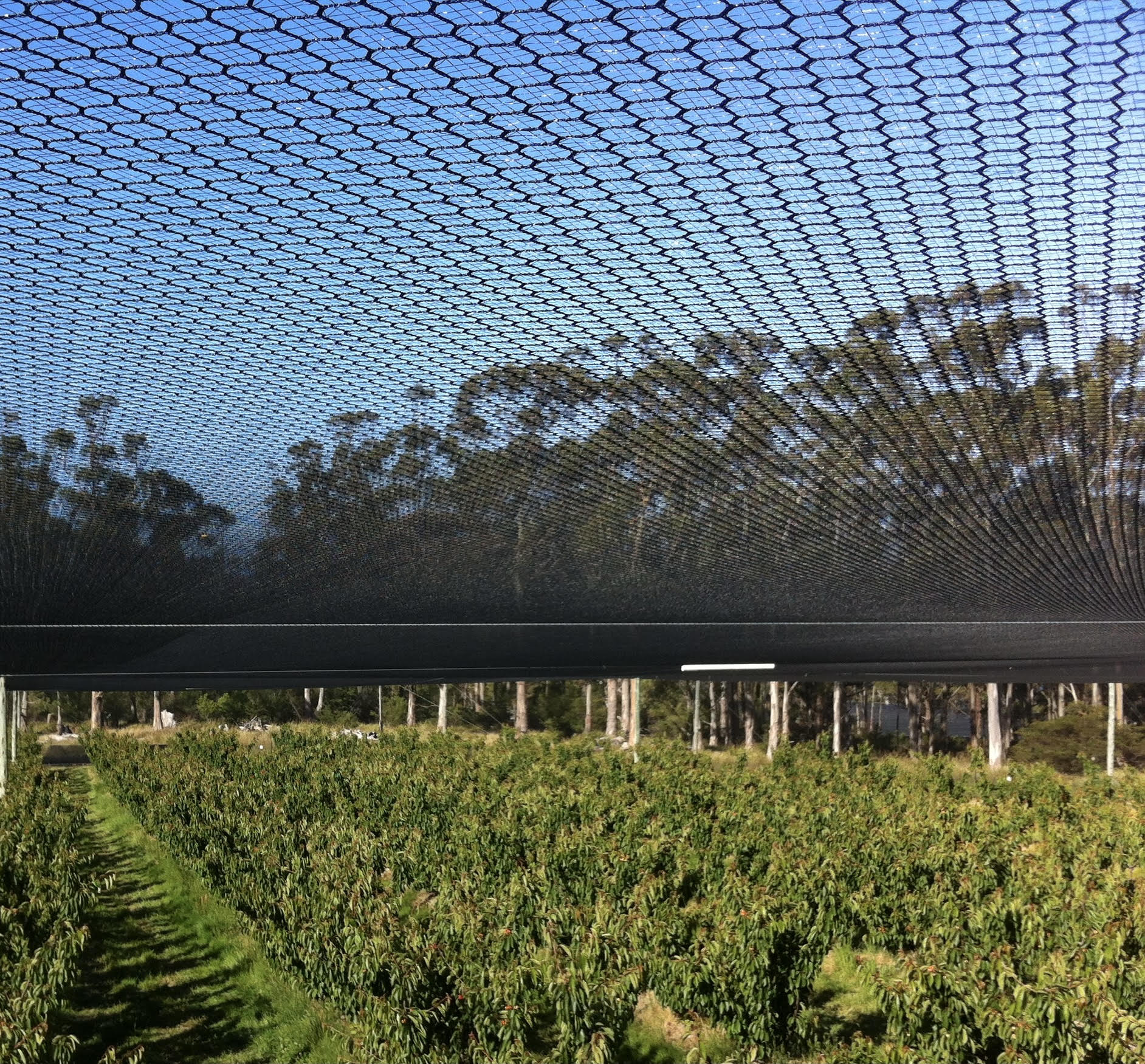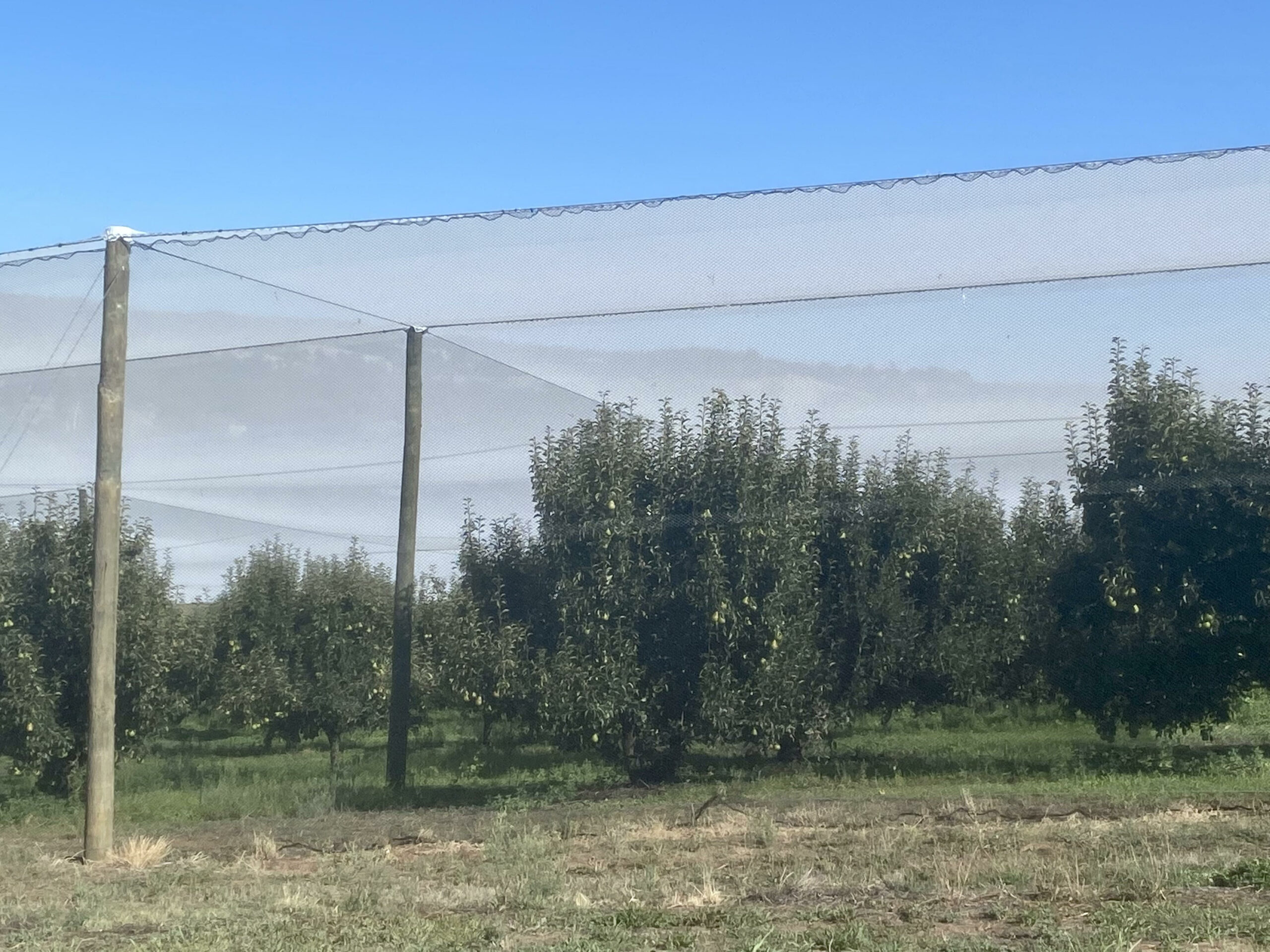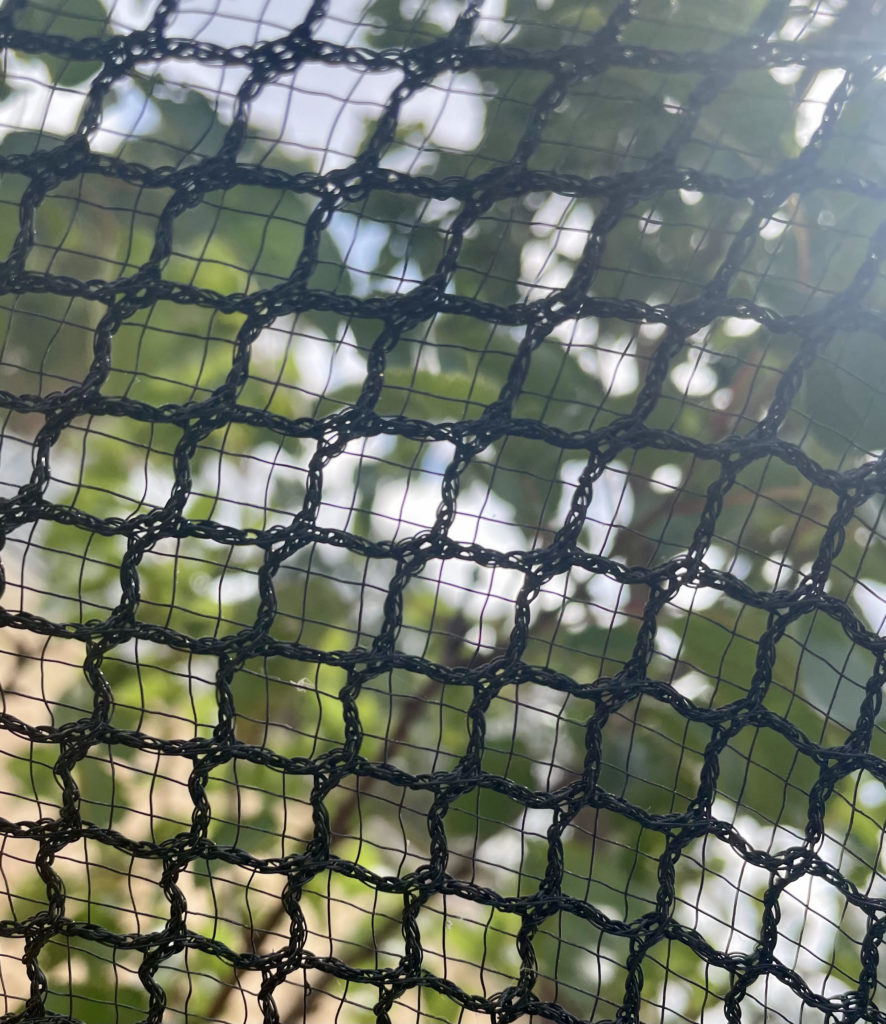
By Environet Canopies.
Hail netting is an important tool for protecting fruit trees from hail damage. However, it is equally important to ensure that enough light penetrates through the netting to promote healthy growth and maximum yield. The amount of light that passes through the hail netting is influenced by several factors such as the net’s colour, thickness, pattern, and the angle and direction of sunlight.
In addition to these factors, the distance between the hail netting and the fruit trees also plays a crucial role in determining the amount of light that passes through. Placing the hail netting directly on top or too close to the fruit trees can result in a significant reduction of light, which can negatively impact growth and yield. This can be especially problematic in areas with limited sunlight.
Therefore, it is essential to carefully consider the spacing between the hail netting and the fruit trees when installing hail netting. The optimal distance between the hail netting and the fruit trees will depend on the specific type of fruit tree, the growing conditions, and the hail protection requirements.
For example, fruit trees such as apples, pears, and peaches require more light than vegetables, and therefore, the hail netting should be installed at a distance away from the trees. This will allow enough light to penetrate through the netting, promoting healthy growth and maximum yield.
In contrast, crops such as leafy vegetables and other low light tolerant crops may be suitable for hail netting installed at a closer distance.
In summary, while hail netting provides an essential layer of protection against hail damage on fruit trees, it is critical to consider the spacing between the hail netting and the fruit trees to ensure adequate light penetration for optimal growth and yield. Consulting with a crop specialist or an experienced hail netting provider can help ensure that the hail netting is properly installed at the optimal distance to meet the specific needs of the fruit trees and growing conditions.



As a grower in Australia, you know all too well the devastating impact that hailstorms can have on your crops. Every year, hailstorms cause millions of dollars in damage to crops across the country, resulting in lower yields, lost income, and even complete crop failure. In fact, hail is responsible for an estimated $30 million in damage to crops annually in Australia. The most hail-prone areas in the country are southeast Queensland, northeast New South Wales, and Northern and Eastern Victoria, where hailstorms are common during the summer months.
In recent years, hailstorms have become increasingly common and severe due to climate change, making it more crucial than ever for growers to protect their crops from hail damage. Even crops that appear to have survived a hailstorm can experience delayed ripening, reduced quality, and decreased market value due to physical damage and bruising caused by hailstones. Hail damage to crops can result in yield losses of up to 100% in some cases, particularly for crops like stone fruit, berries, and grapes.
Fortunately, there is a solution that can help growers mitigate the impact of hailstorms and protect their crops: hail nets. In this article, we’ll explore how hail nets work, the benefits they offer, and how they can help growers ensure their crops stay healthy and productive, even in the face of extreme weather conditions. By the end of this article, you’ll understand why hail nets are an essential investment for any grower who wants to safeguard their crops and livelihood against the destructive force of hail.
Features of the Product
Hail nets are designed to protect crops from the damaging impact of hailstorms. Here are some of the key features of hail nets and how they work:
1. Material: Hail nets are typically made from a high-density polyethylene (HDPE) material, which is a lightweight, durable, and UV-stabilized material that can withstand extreme weather conditions.
2. Mesh Size: The mesh size of hail nets can vary depending on the crop being grown and the size of the hailstones in the area. Generally, smaller mesh sizes are used in areas with smaller hailstones to provide greater protection for the crops.
3. Installation: Hail nets are installed using support structures such as posts, cables, or wires. The nets are usually stretched tightly over the crops to ensure maximum protection.
4. Ventilation: Hail nets are designed to allow for proper ventilation and light transmission, which helps to maintain a healthy growing environment for the crops.
One unique feature of hail nets is that they can be customized to fit the specific needs of the grower and their crops. For example, the mesh size can be adjusted to provide greater protection for more vulnerable crops or to account for larger hailstones in the area. The support structures can also be tailored to fit the layout of the grower’s fields or orchards.
The benefits of these features are clear. By using hail nets, growers can protect their crops from hail damage and ensure a more consistent and reliable yield. For example, a vineyard owner who installs hail nets can protect their grape vines from hailstones and avoid losing an entire season’s crop due to hail damage. Similarly, an orchard grower who uses hail nets can protect their fruit trees from hail damage and ensure a more consistent supply of high-quality fruit for their customers. Overall, the key features of hail nets make them a valuable investment for any grower looking to protect their crops and increase their profitability.

Hail Net Benefits
Hail nets offer a range of benefits for growers, both in general and in specific scenarios. Here are some of the key benefits of using hail nets:
In addition to these general benefits, hail nets can also provide specific benefits for different types of crops and growing scenarios. For example, vineyard owners can use hail nets to protect their grape vines from hail damage, which can help to ensure a more consistent and reliable supply of grapes for winemaking. Similarly, orchard growers can use hail nets to protect their fruit trees from hail damage, which can lead to higher quality fruit and increased profitability.
While hail nets offer many benefits, there are some potential drawbacks and limitations to consider. For example, hail nets can be expensive to install, and they may not be suitable for all types of crops or growing scenarios. However, for many growers, the benefits of using hail nets far outweigh the costs and limitations.
Overall, hail nets are a valuable investment for any grower looking to protect their crops from hail damage and increase their profitability. By providing protection against hail damage, improving crop quality and yield, and reducing pest infestations, hail nets offer a range of benefits that can help growers succeed in even the most challenging growing environments.

We are excited to advise that Applications for the Horticultural Netting Grant are now open.
If you are a Fruit Grower and have been thinking about Net, now is a great time to take advantage of funding.
If you have any questions or would like a quote please contact us
Mark : 0401 077 221
Melinda: 0449 155 569
sales@environetcanopies.com.au
Research indicates that netting delivers productivity benefits by:
Netting helps producers to:
The purpose of the expanded Horticultural Netting Program (the Program) is to provide funding to eligible horticultural enterprises (excluding wine grapes) for the purchase and installation of new netting over established production areas (a ‘project’).
This expanded Program builds upon the previous $4.67 million Commonwealth Government funded Program for the apple and pear industry, by providing an additional $11.22 million for horticultural enterprises, excluding wine grapes. The Department of Jobs, Precincts and Regions (DJPR) has agreed to implement the expanded Program on the Commonwealth Government’s behalf.
Grants are available for eligible horticulture enterprises operating in Victoria. The Program will provide for up to 50 per cent of eligible costs to purchase and commercially install new horticultural netting (fixed and demountable), to a maximum of $150,000 (ex GST). Applicants may also self-install, subject to some exclusions, such as wages and installation equipment.
The number and value of individual grants allocated by the Program will depend upon overall demand. If the Program is oversubscribed, funding will be allocated to successful applicants on a pro-rata basis (a proportion of the amount applied for).
Example: If the Program is oversubscribed by 20 per cent ($13.44 million total), each applicant will be offered 20 per cent less than their requested amount for example, under this scenario a $150,000 application will be offered $120,000.
Applications can be submitted by eligible producers who have had netting already installed after 14 December 2021, and from eligible producers who seek to purchase and install netting before 30 May 2025.
Further detail on edibility for the program can be found in the Program’s guidelines. Please ensure you read the guidelines thoroughly prior to applying to ensure you are eligible.
Horticulture Netting Program Expansion guidelines (PDF – 344.1 KB)
Horticulture Netting Program Expansion guidelines (WORD – 337.3 KB)
The application period for this grants program is between 17 August 2022 and 17 October 2022.
Ensure you read the guidelines first to confirm your eligibility, then if eligible, select the ‘Apply now’ button. This will take you to the Business Victoria website, where you should follow the prompts. Please ensure you have all required documentation ready to include with your submission. Incomplete submissions will not be accepted.Apply now
You will receive an automated email, stating your application has been received. Once the grants close, the assessment process will commence and you will be notified in approximately 8–12 weeks of the outcome.
A legal entity is an association, corporation, trustee of a trust, or individual that has legal standing in the eyes of the law.
A legal entity has legal capacity to:
All enquiries on the Program should be directed to the Program Team at: hort.netting@agriculture.vic.gov.au

Are you taking losses annually from hail, sunburn or bird attack?
You are investing a lot of money in your crops, so you should be protecting your investment.
You can spray to protect your crop, but you need to continually monitor and re-apply sprays—which is good for bugs, fungal disease etc—and can be costly for sunburn and wind rub problems; not to mention bird attack, which can cause considerable losses, resulting in less yield and lost income.
Some orchardists tend to think of net as a last solution to protection, probably because of costs in constructing a protective canopy. However, if you are trying to protect your crops, it is a good investment.
In some cases, a protective canopy can pay itself off in five years because of increased yields, less water evaporation and no bird attack.
Growers who have netting will attest to the benefits of protective canopies. Some growers intend to cover their entire orchards.
Some cherry growers benefit by using drape over nets, as they know the potential damage that can occur from birds. As an orchardist, make enquires about the benefits of netting. It’s a free service with no obligations.
For more information see, Tree Fruit Magazine https://www.treefruit.com.au/orchard/canopies/permanent-structures/76-canopy-pays-for-itself